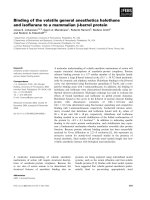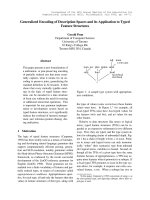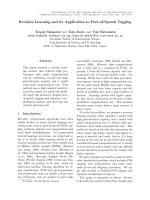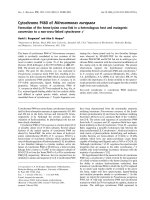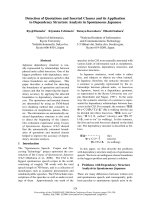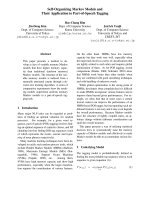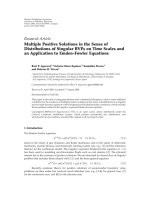Highly enantioselective 1,3 dipolar cyloaddition of azomethine imines and an application to a formal total synthesis of manzacidin c
Bạn đang xem bản rút gọn của tài liệu. Xem và tải ngay bản đầy đủ của tài liệu tại đây (14.09 MB, 202 trang )
Dissertation
Highly Enantioselective 1,3-Dipolar Cycloaddition of Azomethine Imines
and an Application to a Formal Total Synthesis of Manzacidin C
Graduate School of
Natural Science & Technology
Kanazawa University
Division of Material Chemistry
Student ID Number:1424022003
Name:Tong Thi Minh Thu
Chief advisor: Prof. Dr. Yutaka Ukaji
February, 2017
ACKNOWLEDGEMENTS
First of all, I would like to express my sincere thanks to the Vietnamese Government has
given me a great chance to pursue an international doctoral course by their financial support,
under a Vietnam International Education Development Campaign.
I wish to show my deep gratitude to Ba Ria-Vung Tau University, the place I have been
working, has recommended me to apply the Vietnamese scholarship (911 project) and
created advantageous conditions for me to study in Kanzawa University, Japan.
I would acknowledge Kanzawa University and all the staff members of: Graduate School
of Natural Science & Technology, Division of Student Affairs, Division of Material
Chemistry for essential guidance and enthusiastic support throughout the period of
my life and study in Japan.
I would like to express my profound gratitude to my advisor - Prof. Dr. Yutaka Ukaji.
Words do not seem sufficient to let him know I have deep feelings for everything he
graciously taught for me during my study. I treasure the beautiful things he did for
international students that touched me. With my warm regards, I would wish all the best for
his profession and farmily life.
I wish to express my heartfelt thanks to Prof. Takahiro Soeta, Dr.Takuya Suga, and all the
Members of my Laboratory for their thorough guidance, assistance as well as knowledge
exchange. I also thanks for the noteworthy time they spent with me, and that made every day
well worth living. Hopefully, they all are always healthy and will do well in their life.
I would like to thank: Prof. Yoshihito Hayashi, Dr. Keisuke Kawamoto for X-ray analysis
of this study. Prof. Masahito Segi, Prof. Yutaka Ukaji, Prof. Hajime Maeda, Prof. Takahiro
Soeta, Prof. Taniyuki Furuyama, who are my dissertation Referees, have given me valuable
comments and suggestions for completing my dissertation.
I also thankful to all the Lecturers at Kanazawa University and Invited Lecturers, who
imparted to me the precious knowledge during my study.
I also wish to thank all International Fellow Students and Vietnamese Student Association,
Yukio Abe (Oto san), Mi Tetuo (Mi san) for sincere friendship, all their help and for concern
as well as understanding.
As the current of time, I greatly appreciate people who make my life extra special and give
me soothing relief. I would send them my sweet feeling in deep respect for the way they did.
I wish to thank Japan, a country has provided me a big lesson about realistic life. I study
from such things I have experienced. That would enrich my life on the way I wish to be.
Family where the life begins and the love never ends, whenever I think of any of my
successes; or at any time when I seem to be totally failed, I think about them. And I know I
will be fine because of their belief, encouragement, and whole care have given to me with
their endless love. I spay for safety and happiness will stay beside them forever.
It’s time to be thankful for all that godheads give us; bless us and keep us safe in their care.
Kanazawa, February-2017
TONG THI MINH THU
TABLE OF CONTENTS
ABSTRACT ............................................................................................................................... XV
CHAPTER I: GENERAL INTRODUCTION ............................................................................ 1
1.1. Manzacidin C - An overview ................................................................................................ 1
1.1.1. Characterization, application and scientific reality ............................................................... 1
1.1.2. Previous works towards manzacidin C ................................................................................. 3
1.1.2.1. The first total synthesis of manzacidin C by applying Strecker synthesis
(Ohfune group) ................................................................................................................................ 3
1.1.2.2. Total synthesis of manzacidin C using rhodium catalyst by stereospecific C-H bond
oxidation (Dubois group) ................................................................................................................ 4
1.1.2.3. Total synthesis of manzacidin C using asymmetric aza-Mannich reaction
(Lanter
group) .............................................................................................................................................. 5
1.1.2.4. Total synthesis of manzacidin C based on cycloaddition methodologies
(Sibi
group and Leighton group) .............................................................................................................. 6
1.1.2.5. Total synthesis of manzacidin C using diastereoselective hydrogenation reaction of
optically active , -unsaturated esters (Ohfune group) ................................................................. 9
1.1.2.6. Formal total synthesis of manzacidin C (Deng group and Ichikawa group) .................... 10
1.1.3. Conclusion for the previous works towards manzacidin C ................................................. 12
1.2. General aspects for the 1,3-dipolar cycloaddition reaction .............................................. 13
1.2.1. The role of the 1,3-dipolar cycloaddition ............................................................................ 13
1.2.2. The 1,3-dipoles .................................................................................................................... 13
1.2.3. The 1,3-dipolarophiles ........................................................................................................ 14
1.2.4. Mechanic aspects................................................................................................................. 15
1.2.5. Advantages and drawbacks of the 1,3-dipolar cycloaddition ............................................. 16
1.2.5.1. Advantages of the 1,3-dipolar cycloaddition ................................................................... 16
I
1.2.5.2. Drawbacks of the 1,3-dipolar cycloaddition .................................................................... 16
1.2.6. Conclusion for general aspects of the 1,3-dipolar cycloaddition ........................................ 17
1.3. Our previous works - Research background ..................................................................... 18
1.3.1. Concepts for an asymmetric 1,3-dipolar cyloadditions based on chiral multinucleating
system utilizing tartaric acid esters ....................................................................................... 18
1.3.2. Asymmetric 1,3-dipolar cycloaddition of nitrile oxides and nitrones ................................. 19
1.3.2.1. Asymmetric 1,3-dipolar cycloaddition of nitrile oxides .................................................. 19
1.3.2.2. Asymmetric 1,3-dipolar cycloaddition of nitrones .......................................................... 20
1.3.3. Asymmetric 1,3-dipolar cycloaddition of azomethine imines ............................................ 21
1.3.3.1. Asymmetric 1,3-dipolar cycloaddition of azomethine imines to allyl alcohol ................ 22
1.3.1.2. Asymmetric 1,3-dipolar cycloaddition of azomethine imines to 1,4-pentadien-3-ol ...... 23
1.3.1.3. Asymmetric 1,3-dipolar cycloaddition of azomethine imines to homoallylic alcohols ... 24
1.3.1.4. Conclusions for our previous works towards asymmetric 1,3-dipolar cycloadditions .... 26
1.4. Research orientation ............................................................................................................ 27
1.5. Research objective ................................................................................................................ 28
CHAPTER II: HIGHLY ENANTIOSELECTIVE 1,3-DIPOLAR CYCLOADDITION OF
AZOMETHINE IMINES UTILIZING TARTARIC ACID ESTER AS A CHIRAL
AUXILIARY (A Direct Construction of a Pyrazolidine Derivative Possessing the StereoFramework of Manzacidin C) .................................................................................................... 29
2.1. Enantioselective 1,3-dipolar cycloaddition of azomethine imines to methallyl alcohol
(Initial procedure) ....................................................................................................................... 29
2.1.1. General procedure (Initial procedure) ................................................................................. 30
2.1.2. Optimization conditions (Initial procedure) ........................................................................ 30
2.1.3. Scope of substrates (Initial procedure) ................................................................................ 32
2.2. Highly enantioselective 1,3-dipolar cycloaddition of azomethine imines to methallyl
alcohol (Improved procedure).................................................................................................... 33
II
2.2.1. General procedure (Improved procedure) ........................................................................... 34
2.2.2. Optimization of reaction conditions for the 1,3-dipolar cycloaddition
(Improved
procedure).............................................................................................................................. 34
2.2.3. Scope of substrates (Improved procedure) .......................................................................... 37
2.3. Determination of absolute stereochemistry of the cycloadduct ....................................... 38
2.4. Proposed transition state model .......................................................................................... 40
2.5. The first retrosynthetic plan of manzacidin C................................................................... 41
2.6. Summary for chapter II ....................................................................................................... 41
CHAPTER III: DIVERSE APPROACHES FOR THE REMOVAL OF THREE-CARBON
BRIDGE ON TWO NITROGENS IN THE CONSTRUCTED PYRAZOLIDINE RING (C3
UNIT)- (A Basic Study Leading to an Exploration of an Appropriate Synthetic Route for
Manzacidin C) ............................................................................................................................. 42
3.1. Removal strategy of the C3 unit via an oxidation of hydrazine moiety in the produced
cycloadduct followed by an elimination (Synthetic route 1) ................................................... 42
3.1.1. Protection of the hydroxyl group and oxidation of hydrazine moiety in 54a ..................... 43
3.1.2. Elimination under basic conditions ..................................................................................... 43
3.1.2.1. Elimination reaction of 57 under basic conditions ........................................................... 43
3.1.2.2. Elimination reaction of 57a under basic conditions ......................................................... 44
3.1.3. Conclusion for the synthetic route 1 ................................................................................... 45
3.2. Removal strategy of the C3 unit via an introduction of a double bond into
pyrazolidinone moiety derived from the produced cycloadduct (Synthetic route 2) ............ 46
3.2.1. Introduction of the double bond into the pyrazolidinone moiety ........................................ 46
3.2.1.1. Sulfenylation reaction ...................................................................................................... 46
3.2.1.2. Oxidation and dehydrosulfenylation reactions ................................................................. 47
3.2.2. Diverse transformations relying on the introduced double bond ....................................... 48
3.2.2.1. Transformation relying on an enamine functional group ................................................. 49
III
3.2.2.2. Transformation relying on hydroxylamine and enamine functional groups .................... 49
3.2.2.3. Transformation relying on an alkene functional group .................................................... 50
3.2.3. Conclusion for the synthetic route 2 ................................................................................... 53
3.3. Removal strategy of the C3 unit via an introduction of bis(methylthio-) substituted in
the pyrazolidinone moiety (Synthetic route 3) .......................................................................... 54
3.3.1. Bis-sulfenylation reaction ................................................................................................... 54
3.3.2. Desulfenylation reaction ..................................................................................................... 55
3.3.3. Transformations based on functional groups resulting from the oxidative hydrolysis of the
dithioacetal in 61 ................................................................................................................... 56
3.3.3.1. Transformation via the hydrolysis of 71 .......................................................................... 56
3.3.3.2. Transformations via an introduction of a hydroxyl group into 70 ................................... 56
3.3.3. Transformation via the reduction of the amide carbonyl in 61 ........................................... 60
3.3.4. Conclusion for the synthetic route 3 ................................................................................... 61
3.4. Removal strategy of the C3 unit via a reduction of N-N bond incorporated in the ring
of the produced cycloadduct (Synthetic route 4) ...................................................................... 62
3.4.1. Examination for the reductive cleavage reactions of the N-N bond ................................... 62
3.4.2. Introduction of a double bond into 74 and functional group transformations .................... 64
3.4.2.1. Introduction of a double bond in 74 via sulfenylation and selenation reactions .............. 64
3.4.2.2. Functional group transformations based on the introduced double bond ........................ 65
3.4.3. Introduction of the double bond after Boc-protection of amide and amine moieties ......... 67
3.4.3.1. Boc-Protection of amide and amine moieties .................................................................. 67
3.4.3.2. Introduction of a double bond into 79 via a sulfenylation ............................................... 67
3.4.4. Introduction of a double bond after Bz- protection of amide and amine moieties .............. 68
3.4.4.1. Bz-Protection of amide and amine moieties .................................................................... 68
3.4.4.2. Introduction of a double bond into 80 and 81 via a selenylation ..................................... 69
3.4.5. Functional group transformation via an introduction of a hydroxyl group into 74............. 70
IV
3.4.5.1. Introduction of a hydroxyl group into 74 by reactions with an oxazaridine ................... 70
3.4.5.2. Introduction of a hydroxyl group by a reduction of an amide carbonyl in 74 ................. 71
3.4.6. Conclusion for the synthetic route 4 ................................................................................... 71
3.5. Summary for chapter III ..................................................................................................... 72
CHAPTER IV: A FORMAL TOTAL SYNTHESIS OF MANZACIDIN C (SUCCESSFUL
SYNTHETIC ROUTE) - The First Development for the Removal of Three-Carbon Bridge
on Two Nitrogens in the Formed Pyrazolidine Ring) .............................................................. 73
4.1. Removal strategy of the C3 unit through N–N bond cleavage followed by a retroMichael addition reaction (Synthetic route 5- Successful route) ........................................... 73
4.1.1. Working hypothesis on the basic of the studies from unsuccessful routes ......................... 73
4.1.2. Protection of amine and amide moieties by di-tert-butyl dicarbonate (Boc-protection) .... 76
4.1.3. The first examination for the ring-opening reaction using a Grignard reagent ................... 77
4.1.3.1. Examination for the ring-opening reaction using phenylmagnesium bromide ................ 77
4.1.3.2. Study for mechanism of the formation of the byproduct ................................................. 77
4.1.4. The second retrosynthetic plan for the synthesis of manzacidin C ..................................... 78
4.2. Construction of the stereo-framework of manzacidin C and the protection of the
hydroxyl group on the constructed cycloadduct ...................................................................... 79
4.2.1. Construction of the stereo-framework of manzacidin C ..................................................... 79
4.2.2. Protection of the hydroxyl group in the obtained cycloadduct ........................................... 79
4.2.2.1. Requirement for the protection of the hydroxyl group .................................................... 79
4.2.2.2. Optimization conditions for the protection of the hydroxyl group .................................. 80
4.3. Reduction of the N-N bond incorporated in the cycloadduct........................................... 81
4.3.1. Optimization of the reaction conditions for the reduction of the N-N bond ....................... 81
4.3.2. Reduction of the N-N bond under optimized conditions .................................................... 82
4.4. Protection of amide and amine moieties ............................................................................ 82
4.4.1. Screening of reaction conditions for the protection of amide and amine moieties ............. 82
V
4.4.2. Investigation on mechanism of the byproduct 83 formation ............................................... 84
4.4.3. Optimization conditions for the stepwise-protection of amide and amine moieties ........... 85
4.5. Ring-opening and esterification reactions.......................................................................... 86
4.5.1. Optimization of the reaction conditions for the ring-opening reaction ............................... 86
4.5.2. Optimization conditions for sequential ring-opening and esterification reactions ............. 87
4.6. Elimination reaction ............................................................................................................. 87
4.6.1. Base mediated elimination reaction .................................................................................... 87
4.6.2. Elimination reaction via an introduction of a double bond on the propanoate branch ....... 88
4.6.3. Elimination reaction promoted by Lithium bis(trimethylsilyl)amide (LiHMDS) .............. 90
4.6.3.1. Investigation on mechanism of the elimination reaction by (TLC) monitoring .............. 91
4.6.3.2. Tentatively proposed mechanism for the elimination reaction ........................................ 92
4.6.3.3. Optimization conditions for the elimination reaction ...................................................... 93
4.6.4. Elimination reaction under optimized conditions ............................................................... 96
4.6.5. The regiochemistry of the Boc group in 90......................................................................... 96
4.7. Oxidation of phenyl group in 90 ......................................................................................... 97
4.7.1. The first expected synthetic pathway from the elimination reaction towards the synthesis
of manzacidin C .................................................................................................................... 97
4.7.2. Examination for the oxidation reaction of the phenyl group in 90 ..................................... 97
4.8. Hydrolysis reaction of the urea ring ................................................................................... 99
4.8.1. The second expected synthetic pathway from the elimination reaction towards the
synthesis of manzacidin C ..................................................................................................... 99
4.8.2. Optimization conditions for the hydrolysis of the urea ring 90 ........................................ 100
4.9. Protective reactions after the hydrolysis reaction of the urea ring 90 .......................... 100
4.9.1. Protection for amines resulting from a neutralization of the ammonium salt 94 .............. 100
4.9.1.1. Optimization of the reaction conditions for the protection of amine moieties............... 100
4.9.1.2. Optimization conditions for sequential hydrolysis and protection reactions ................. 101
VI
4.9.2. Optimization conditions for the acetylation of the hydroxyl group in 95 ......................... 102
4.10. Oxidation of the phenyl group in 97 and subsequent lactonization reaction ............. 102
4.10.1. Oxidation reaction of the phenyl group in 97 ................................................................. 102
4.10.1.1. Optimization of reaction conditions for the oxidation of the phenyl group ................. 102
4.10.1.2. Optimized conditions for the oxidation of the phenyl group in 97 .............................. 105
4.10.2. Optimization conditions for sequential oxidation and lactonization reactions ............... 106
4.10.3. Three known steps from the achieved lactone towards manzacidin C ........................... 107
4.11. Summary for chapter IV ..................................................................................................... 108
CHATER V: A SUMMARY FOR FRUITFUL OUTCOMES, A PROPOSAL OF AN
EXTENSIVE APPLICATION, GENERAL CONCLUSIONS ............................................. 109
5.1. Fruitful Outcomes .............................................................................................................. 109
5.1.1. Summary for the development of the 1,3-dipolar cycloaddition reaction of azomethine
imines .................................................................................................................................. 109
5.1.2. Summary for the formal total synthesis of manzacidin C ................................................. 111
5.1.2.1. The early synthetic stages .............................................................................................. 111
5.1.2.2. The late synthetic stages ................................................................................................. 112
5.2. A proposal for an extensive application of the present study ........................................ 114
5.3. General conclusions............................................................................................................ 116
EXPERIMENTAL AND ANALYTICAL DATA .................................................................. 117
SUPPORTING INFORMATION ............................................................................................ 132
REFERENCES AND NOTES .................................................................................................. 133
APPENDIX ................................................................................................................................ 137
VII
LIST OF TABLES
Table II- 1. Optimization of reaction conditions for the 1,3-dipolar cycloaddition
(Initial procedure). ......................................................................................................................... 31
Table II- 2. Scope of substrates under optimized conditions of the initial procedure. ................ 33
Table II- 3. Optimization of reaction conditions for the 1,3-dipolar cycloaddition
(Improved
procedure)...................................................................................................................................... 35
Table II- 4. Scope of substrates under optimized conditions of the improved procedure. .......... 37
Table III- 1. Examination of various bases on the elimination reaction of 57............................. 44
Table III- 2. Optimization of reaction conditions for the sulfenylation. ...................................... 47
Table III- 3. Optimization of reaction conditions for the oxidation and dehydrosulfenylation. .. 48
Table III- 4. Examination for the introduction of the hydroxyl group by the reduction of the
amide carbonyl in 63. .................................................................................................................... 50
Table III- 5. Results of the hydrolytic cleavage of the dithioacetal in 61. ................................... 55
Table III- 6. Examination of various oxidants for the introduction of the hydroxyl group. ....... 58
Table III- 7. Examination of various reductants for the reduction of the amide carbonyl. ......... 61
Table III- 8. Results of the Bz-protection of amide and amine moieties. .................................... 68
Table III- 9. Examination for an introduction of a double bond into 81. .................................... 70
Table IV- 1. Influence of the free hydroxyl group on the reduction of the N-N bond. ................ 80
Table IV- 2. Optimization of the reaction conditions for the reduction of the N-N bond. .......... 81
Table IV- 3. Results of the protection of amide and amine moieties under various conditions. . 83
Table IV- 4. Optimization of the reaction conditions for the ring-opening reaction. .................. 86
Table IV- 5. Results for the introduction of an electrophile on the propanoate brand. ................ 89
Table IV- 6. Effect of temperature on the elimination reaction promoted by LiHMDS. ............ 90
VIII
Table IV- 7a. Optimization of reaction conditions for the elimination reaction. ......................... 94
Table IV- 8. Result of examinations for the oxidation of phenyl group in 90. ............................ 98
Table IV- 9. Optimization of the reaction conditions for the protection of amine moieties. ..... 101
Table IV- 10. Optimization of reaction conditions for the oxidation of the phenyl group. ....... 103
IX
LIST OF FIGURES
Figure I- 1. Structure of manzacidins A-D..................................................................................... 1
Figure I- 2. 1,3-Dipolar types. ...................................................................................................... 14
Figure I- 3. FMO diagram of 1,3-dipolar cycloaddition reaction. ............................................... 15
Figure I- 4. An illustration for the 1,3-dipolar cycloaddition reaction......................................... 16
Figure I- 5 (A, B). Illustration for the concept of an asymmetric 1,3-dipolar cyloaddition on the
basic of chiral multinucleating system utilizing tartaric acid esters. ............................................. 19
Figure I- 6. Envisaged synthetic methodology for the synthesis of manzacidin C. ..................... 27
Figure II- 1. Proposed transition state model. .............................................................................. 40
Figure IV- 1. Studying the causes of unsuccessful synthetic routes. ........................................... 73
Figure IV- 2. Reaction Design. .................................................................................................... 75
Figure IV- 3. Expected synthetic pathway. .................................................................................. 76
Figure IV- 4. Proposed mechanism for the formation of the byproduct. ..................................... 77
Figure IV- 5. Proposed mechanism for the formation of the byproduct. ..................................... 84
Figure IV- 6. Investigation on mechanism of the elimination reaction by TLC monitoring. ...... 91
Figure IV- 7. Tentatively proposed mechanism for the elimination reaction. ............................. 92
Figure IV- 8. Brief summary for the formal total synthesis of manzacidin C. .......................... 108
Figure V- 1. Summary for the developed 1,3-dipolar cycloaddition reactions. ......................... 109
Figure V- 2. Summary for the early stages of the formal total synthesis of manzacidin C. ...... 112
Figure V- 3. Summary for the late stages of the formal total synthesis of manzacidin C.......... 113
Figure V- 4. Representative examples of the 1,3-dipolar cycloaddition of azomethine imines. 114
Figure V- 5. Illustration for an extensive application of the present study. ............................... 115
X
LIST OF SCHEMES
Scheme I- 1. The first total synthesis of manzacidin C by applying Strecker synthesis. ............... 3
Scheme I- 2. Total synthesis of manzacidin C by stereospecific C-H bond oxidation. ................. 4
Scheme I- 3. Total synthesis of manzacidin C using asymmetric aza-Mannich reaction. ............. 5
Scheme I- 4. Total synthesis of manzacidin A and (ent)-manzacidin C using Lewis acid
catalyzed asymmetric 1,3-dipolar cycloaddition. ............................................................................ 7
Scheme I- 5. Total synthesis of manzacidin C using chiral silicon-based Lewis acid promoted
asymmetric [3+2] cycloaddition...................................................................................................... 8
Scheme I- 6. Total synthesis of manzacidin C using diastereoselective hydrogenation of
,-dehydroamino acid ester........................................................................................................... 9
Scheme I- 7. Formal total synthesis of manzacidin C by using cinchona alkaloid catalyzed an
asymmetric Michael addition. ....................................................................................................... 10
Scheme I- 8. Formal total synthesis of manzacidin C using allyl cyanate-to-isocyanate
rearrangement. ............................................................................................................................... 11
Scheme I- 9. Application of the asymmetric 1,3-dipolar cycloaddition of nitrile oxides to the
total synthesis of (–)-lasubine II. ................................................................................................... 20
Scheme I- 10. Application of the asymmetric 1,3-dipolar cycloadditions of nitrones to the
synthesis of a key component of polyoxin E................................................................................. 21
Scheme I- 11. Stoichiometric asymmetric 1,3-dipolar cycloaddition of azomethine imines ....... 22
Scheme I- 12. Catalytic asymmetric 1,3-dipolar cycloaddition of azomethine imines ................ 23
Scheme I- 13. Stoichiometric asymmetric 1,3-dipolar cycloaddition of azomethine imines ....... 23
Scheme I- 14. The catalytic asymmetric 1,3-dipolar cycloaddition of azomethine imines .......... 24
Scheme I- 15. Stoichiometric asymmetric 1,3-dipolar cycloaddition of azomethine imines to
homoallylic alcohol. ...................................................................................................................... 24
XI
Scheme I- 16. Catalytic asymmetric 1,3-dipolar cycloaddition of azomethine imines ................ 25
Scheme I- 17. Asymmetric 1,3-dipolar cycloaddition of 47a to homoallylic alcohol 51B. ......... 25
Scheme II- 1. Determination of absolute stereochemistry of 54a. ............................................... 38
Scheme II- 2. Determination of absolute stereochemistry of 54e. ............................................... 39
Scheme II- 3. The first retrosynthetic plan of manzacidin C. ...................................................... 41
Scheme III- 1. Expected synthetic pathway. ................................................................................ 42
Scheme III- 2. Protection of a hydroxyl group and an oxidation of a hydrazine moiety. ............ 43
Scheme III- 3. Transformation of 57 to 57a towards the elimination reaction. ........................... 45
Scheme III- 4. Expected synthetic pathway. ................................................................................ 46
Scheme III- 5. Examination for a hydrolysis of an enamine functional group. ........................... 49
Scheme III- 6. Expected synthetic pathway. ................................................................................ 49
Scheme III- 7. Expected synthetic pathway. ................................................................................ 50
Scheme III- 8. Examination for the oxidative cleavage reaction by an ozonolysis reaction. ...... 51
Scheme III- 9. Examination for the oxidative cleavage reaction using a periodate agent. .......... 52
Scheme III- 10. Examination for the oxidative cleavage reaction using potassium permanganate
and sodium periodate. ................................................................................................................... 53
Scheme III- 11. Expected synthetic pathway. .............................................................................. 54
Scheme III- 12. Synthesis of 61. .................................................................................................. 54
Scheme III- 13. Examination for a hydrolysis reaction of 71. ..................................................... 56
Scheme III- 14. Expected synthetic pathway. .............................................................................. 57
Scheme III- 15. Examination for the introduction of the hydroxyl group into 70
by a reaction with an oxaziridine. ................................................................................................. 59
Scheme III- 16. Examination for the introduction of the hydroxyl group
via
the reduction of the amide carbonyl in 70. .................................................................................... 59
XII
Scheme III- 17. Expected synthetic pathway. .............................................................................. 60
Scheme III- 18. Expected synthetic pathway. .............................................................................. 62
Scheme III- 19. Examination for the reductive cleavage of N-N bond in 69. ............................. 62
Scheme III- 20. Examination for the reductive cleavage of N-N bond in 61. ............................. 63
Scheme III- 21. Examination for the reductive cleavage of N-N bond in 56. ............................. 63
Scheme III- 22. Introduction of a double bond in 74 via sulfenylation using dimethyl disulfide.
....................................................................................................................................................... 64
Scheme III- 23. Introduction of a double bond in 74 via selenation using phenylselenyl chloride.
....................................................................................................................................................... 65
Scheme III- 24. Examination for hydrolysis reactions of 76B and 78. ........................................ 66
Scheme III- 25. Examination for an oxidative cleavage reaction of 78. ...................................... 66
Scheme III- 26. Examination for Boc-protection of the amide and amine moieties.................... 67
Scheme III- 27. Examination for an introduction of a double bond into 79. ............................... 68
Scheme III- 28. Examination of an introduction of a double bond into 80. ................................ 69
Scheme III- 29. Examination for an introduction of a hydroxyl group into 74 ........................... 71
Scheme III- 30. Examination for a reduction of an amide carbonyl in 74. .................................. 71
Scheme III- 31. General illustration for the removal strategies of the C3 unit. ........................... 72
Scheme IV- 1. Result of the Boc-protection of amide and amine moieties. ................................ 76
Scheme IV- 2. The first examination for a ring-opening reaction................................................ 77
Scheme IV- 3. The second retrosynthetic plan for the synthesis of manzacidin C. ..................... 78
Scheme IV- 4. Construction of the stereo-framework of manzacidin C. ..................................... 79
Scheme IV- 5. Protection of the hydroxyl group under optimized conditions. ............................ 80
Scheme IV- 6. Reduction of the N-N bond under optimized conditions. .................................... 82
Scheme IV- 7. Stepwise-protection of amide and amine moieties under optimized conditions. . 85
Scheme IV- 8. Ring-opening and esterification reactions under optimized conditions. .............. 87
XIII
Scheme IV- 9. Base mediated elimination reaction. .................................................................... 88
Scheme IV- 10. Expected synthetic pathway. .............................................................................. 88
Scheme IV- 11. Elimination reaction under optimized conditions. ............................................. 96
Scheme IV- 12. The regiochemistry of the Boc group in 90. ....................................................... 96
Scheme IV- 13. The first expected pathway from the elimination step towards manzacidin C. . 97
Scheme IV- 14. The second expected pathway from the elimination step towards manzacidin C.
....................................................................................................................................................... 99
Scheme IV- 15. Hydrolysis of the urea ring under optimized conditions. ................................. 100
Scheme IV- 16. Sequential hydrolysis of 90 and protection of amines moieties in 94. ............. 101
Scheme IV- 17. Acetylation of the hydroxyl group in 95 under optimized conditions. ............ 102
Scheme IV- 18. Oxidation of the phenyl group under optimized conditions. ........................... 105
Scheme IV- 19. Oxidation and lactonization reactions under optimized conditions. ................ 106
Scheme IV- 20. Three known steps from the achieved lactone 100 towards manzacidin C...... 107
XIV
ABSTRACT
Manzacidins A-C were first isolated from Okinawan sponge Hymeniacidon sp. These
compounds were realized to an unprecedented class of bromopyrrole alkaloids due to their
unique structures consisting of an ester-linked bromopyrrolecarboxylic acid and an unusual
tetrahydropyrimindine ring. Thus, manzacidins were expected to exhibit an array of prominent
pharmacological activities as their alkaloid family, such as USP7 inhibitor, actomyosin ATPase
activators, antagonists of serotonergic receptors, α-adrenoceptor blockers, etc.
To date, manzacidins have become as target natural products and attracted much attention
from the synthetic community. These facts stem from the intriguing structural features of their
1,3-diamine skeletons with a quaternary stereocenter and a desire to obtain significant amounts
for more comprehensive pharmacological studies.
Manzacidins A and C have a 2,4-diamino-5-hydroxypentanoic acid skeleton that possesses a
nitrogen-containing quaternary carbon center at the 4-position. In order to construct such a chiral
backbone, many synthetic approaches to them have been explored. However, development of a
synthetically useful method for the construction of 1,3-diamine skeletons is still a challenging
task in terms of selectivity, atom economy or efficient reaction.
Among the numerous types of known organic reactions are available, asymmetric 1,3-dipolar
cycloadditions have been well-known as a useful and effective tool to directly construct such
novel structure motifs in organic synthesis. Recently, we have developed the asymmetric 1,3dipolar cycloaddition of azomethine imines to allylic and homoallylic alcohols, utilizing either
stoichiometric or catalytic amounts of diisopropyl (R,R)-tartrate [(R,R)-DIPT] to furnish transpyrazolidines with excellent regio-, diastereo-, and enantioselectivities. Based on our previous
results, we envisaged that if our method could be applied to the cycloaddition of azomethine
imines to methallyl alcohol, the (S,S)-2,4-diamino-2-methylbutan-1-ol (B) could be constructed
by the use of (S,S)-DIPT through the cycloadduct as shown in Scheme 1. In the case of the
XV
cycloadduct derived from a phenyl-substituted azomethine imine by the use of (S,S)-DIPT, the
oxidation of the phenyl ring moiety might provide a ready route to the carboxylic acid
functionality (A). Manzacidin C could be then achieved in several transformations. In this
approach, the removal of three carbons bridge on two nitrogens in the formed pyrazolidine ring
(denoted by C3 unit) is crucial in synthesizing manzacidin C.
Scheme 1. Retrosynthetic plan of manzacidin C.
Herein I wish to report the formal total synthesis of manzacidin C based on asymmetric 1,3dipolar cycloaddition of the azomethine imine utilizing (S,S)-DIPT as a chiral auxiliary. In
addition, the C3 unit on nitrogens of the obtained cycloadduct could be removed through N–N
bond cleavage followed by a retro-Michael addition reaction.
These results are presented in detail of this dissertation, including following parts:
Chapter I provides general introduction for what I want to work on and how it are interesting,
scientific, and realistic. These contents consist of 1) context of the research area; 2) previous
studies including key literatures; 3) research background; 4) research orientation; 5) research
objectives.
Chapter II focuses mainly on the development of asymmetric 1,3-dipolar cycloaddition of
azomethine imines to methallyl alcohol for the constructions of the corresponding pyrazolidines
possessing two contiguous stereogenic centeres in which one is a quaternary carbon. The
developed procedure general was that: when a mixture of the azomethine imine (1.0 equiv),
methallyl alcohol (1.0 equiv), and chiral diisopropyl tartrate (DIPT) (1.0 equiv) was treated with
XVI
a Grignard reagent (3.0 equiv), the asymmetric 1,3-dipolar cycloaddition reaction was proceeded
smoothly to give the corresponding cycloadducts in high chemical yields (up to 77%), excellent
enantioselectivities (up to 97%) and complete diastereselectivities.
Furthermore, in the case of the cycloadduct derived from a phenyl-substituted azomethine
imine by the use of (S,S)-DIPT, two chiral centers with suitable functional groups for the
synthesis of manzacidin C was achieved in good chemical yield (59%) and excellent
enantioselectivity (95% ee). The absolute stereochemistry of this cycloadduct has been
determined. Recrystallization of the obtained cycloadduct enhanced the optical purity of the
cycloadduct up to 99.4% ee, which was then subjected to further transformations towards the
total synthesis of manzacidin C.
Chapter III provides diverse approaches for the removal of the C3 unit, involving four
synthetic routes as illustrated in Scheme 2.
Route 1 is a removal strategy of the C3 unit via an oxidation of a hydrazine moiety on the
produced cycloadduct followed by an elimination under basic treatments. Although various
experiments were carried out, the results gave us unexpected elimination compounds which
possibly caused by a deprotonation of the benzylic proton on the produced cycloadduct. For this
reason, the synthetic route should be imposed on alternative ones.
Route 2 is a removal strategy of the C3 unit via an introduction of a double bond into
pyrazolidinone moiety derived from the produced cycloadduct (namely pyrazolidinone moiety
for a short). The introduction of the double bond could be well-controlled. Subsequent
transformations relying on the introduced double bond have been performed (hydrolysis,
XVII
oxidative cleavage reactions, etc.). The results gave usunexpected compounds or starting
material was mostly recovered.
Scheme 2. General illustration for the removal strategies of the C3 unit.
Route 3 is a removal strategy of the C3 unit via an introduction of bis(methylthio-) substituted
on the pyrazolidinone moiety. Bis-sulfenylation reaction was smoothly proceeded. Followed by a
desulfenylation would generate a new ketone functional group and further reactions could be
then easily accessible towards to the synthesis of manzacidin C, our predication. To our surprise,
instead of the formation of the desired product from the desulfenylation, other unpredicted
compounds possessing a double bond on their scaffold were formed. In order to make good use
of unpredictably obtained compounds, many transformations were executed but such synthetic
routes were again not successful.
Based on the results of the Synthetic route 2 and route 3 and studying the causes of the failure
reactions. We recognized that the low reactivity probably caused by: (1) the aromaticity of the
XVIII
compounds generated by the introduction of the double bond; (2) the high resonance stabilization
between the nitrogen-carbon and carbon-oxygen bond on the produced cycloadduct.
From our study, the characteristic of the produced cycloadduct must be changed in order to
deal with these issues. In other words, a new approach need to be developed (Synthetic route 4).
Route 4 is a removal strategy of the C3 unit via the reduction of N-N bond incorporated in the
ring of the produced cycloadduct. The reductive cleavage reaction of the N-N bond could be
smoothly proceeded. Followed by a series of transformations have been made. Expected results
have not yet been attained under examined reactions. However, the given results led us to
explore a right approach (Synthetic route 5) and this route was clearly described in Chapter IV.
Chapter IV provides full data for the successful route (Synthetic route 5) as follows:
Route 5 is a removal strategy of the C3 unit through N–N bond cleavage followed by a retroMichael addition reaction. A hypothesis of this synthetic route was given by studying the causes
of the unsuccessful routes. On the basic of such investigations, an appreciate retro-synthetic plan
has been exploited to be able to access the enantioselective total synthesis of manzacidin C, as
shown in Scheme 3.
Scheme 3. Synthetic route towards manzacidin C.
To be more specific, the cycloadduct possessing the stereo-framework of manzacidin C was
first constructed. The C3 unit could be then removed through N–N bond cleavage followed by a
retro-Michael addition reaction. Subsequent oxidation of the remaining phenyl group into a
XIX
corresponding carboxylic acid followed by lactone formation was realized to furnish the knownlactone (as a final key intermediate for the total synthesis of manzacidin C). Thus, a formal total
synthesis of manzacidin C has been accomplished. The synthetic sequence was 11 steps. The
results and discussions were clearly given in this chapter.
Chapter V provides (1) a general summary for fruitful outcomes; (2) a proposal for an
extensive application of the present study; and (3) general conclusions.
Experimental and analytical parts provide detail data for optimization conditions of the
reactions which were presented in Chapter II and Chapter IV.
Supporting information provides the spectral data including 1H NMR,
13
C NMR, HPLC
spectra for optimization conditions of the reactions which were presented in Chapter II and
Chapter IV.
In summary, we have successfully developed:
1) The 1,3-dipolar cycloaddition reactions of azomethine imines to methallyl alcohol utilizing
chiral diisopropyl tartrate (DIPT) as a chiral auxiliary for the construction of the pyrazolidines
possessing two contiguous stereogenic centers in which one is a quaternary carbon with complete
diastereoselectivities, excellent enantioselectivities and in high chemical yields.
2) An efficient synthetic methodology to access enantioselective formal total synthesis of
manzacidin C in 11 step sequences with high to excellent chemical yields. The formal total
synthesis of manzacidin C was accomplished through the removal of the C3 unit of the
cycloadduct which produced by the asymmetric 1,3-dipolar cycloaddition of the phenylsubstituted azomethine imine to methallyl alcohol using (S,S)-DIPT as a chiral auxiliary.
It is noteworthy that the results from the present study would be widely applicable in synthetic
chemistry and receive much attention from chemists because the conversion of the produced
fused pyrazolidines to acyclic 1,3-diamine derivatives has not yet been achieved to the best of
our knowledge although many asymmetric 1,3-dipolar cycloadditions of azomethine imines
possessing pyrazolidinone moieties to olefins have been reported.
XX
CHAPTER I: GENERAL INTRODUCTION
This chapter provides general introduction for what I want to work on and how it are
interesting, scientific, and realistic. Such contents consist of 1) context of the research area; 2)
previous studies including key literatures; 3) research background; and 4) research objectives.
These contents are clearly presented at the following sections.
1.1. Manzacidin C - An overview
1.1.1. Characterization, application and scientific reality
Bromopyrrole alkaloids have been recognized as a novel family of marine natural products
which are known to exhibit a diverse array of prominent pharmacological activities. Their
biological activities cover USP7 inhibitor, actomyosin ATPase activators, antagonists of
serotonergic receptors, α-adrenoceptor blockers, antifungal activity, anti-inflammatory activity,
antimicrobial activities etc.1 In addition to these compounds, more than 140 derivatives with
different structures and biological activities have been isolated from more than 20 different
sponges etc., reported by Rane group in 2014, a review for "marine bromopyrrole alkaloids".2
In 1991, Kobayashi group reported the first isolation of three novel compounds, namely
manzacidins A, B and C from an Okinawan sponge Hymeniacidon sp. and the isolation of
manzacidin D from the coralline demosponge Astrosclera willeyana was then reported in 1997
by another group, (Figure I-1). These compounds were realized to an unprecedented class of
bromopyrrole alkaloids due to their intriguing structures, consisting of an ester-linked
bromopyrrolecarboxylic acid and an unusual tetrahydropyrimidine ring.3
Figure I- 1. Structure of manzacidins A-D.
Page 1
Manzacidins have become as target natural products and attracted great attention from the
synthetic community due to the facts that: (1) Such their unique structures containing an
extraordinary tetrahydropyrimidine core bearing two consecutive stereogenic centers in which
one of the amino groups is attached to quaternary carbon centers, and thereby manzacidins were
expected to display a very rich source of bioactive molecules as those of other bromopyrrole
alkaloids. However, a pharmacological profile of manzacidins has not yet been exploited due to
the scare from natural sources. These led to a desire to obtain significant quantities of them for
more comprehensive pharmacological studies. (2) On the other hand, a nitrogen substituted
quaternary carbon stereogenic center not only exists in manzacidins but also displays in
numerous natural products and the development of a synthetically useful method for
enantioselective constructions of such structure motifs has been considering as one of the most
formidable challenges in organic synthesis.4
In other words, manzacidins are considered as highly potential candidates for examining new
synthetic methodologies for the construction of such novel structures. Up to the present,
accessing an enantioselective total synthesis of these compounds has been raising a significant
attention from chemists. As a result, many research groups have reported their diverse
approaches to attain manzacidins, demonstrating the power of novel synthetic methodologies.
In 2012, Ohfune group has reported a review for an overview of the total synthesis of the
manzacidins.5 Among these studies, the first synthesis from his group has proven as a precious
guideline in the context of the natural product synthesis, manzacidins. Since their report, many
efforts have been made to access enantioselective total synthesis of these compounds.
In the framework of this dissertation, I will focus mainly on previous works for a total
synthesis of manzacindin C which is the synthesized target compound of the present study.
For the total synthesis of manzacidin C, seven studies have been reported, and thus I wish to
provide a brief summary for such reports to realize the scientific reality of the present research
area.
Page 2
1.1.2. Previous works towards manzacidin C
1.1.2.1. The first total synthesis of manzacidin C by applying Strecker synthesis
(Ohfune group)
In 2000, Ohfune group reported the first total synthesis of manzacidins A and C as well as the
absolute configuration of these compounds was unambiguously confirmed. The synthetic
sequence of manzacidin C included 15 steps and the overall yield was 3.5%.5,6
Scheme I- 1. The first total synthesis of manzacidin C by applying Strecker synthesis.
As shown in Scheme I-1, this route applied the asymmetric Strecker synthesis to construct
(6S)-amino nitrile 4. At first, the Strecker precursor, D-Phe isomer 2 was prepared in 3 steps
starting from (2S)-allylglycinol (1). Subsequently, selective removal of the Boc group in D-Phe
isomer 2 afforded the corresponding imine 3. (6S)-amino nitrile 4 was constructed via the
addition of nitrile to the imine occurred from the opposite side of the carbon subsituted benzyl
group. The lactone was then prepared in 11 steps via the formation of the cyclic urea 5 and diol 6,
Page 3


